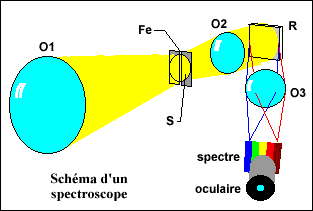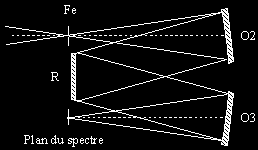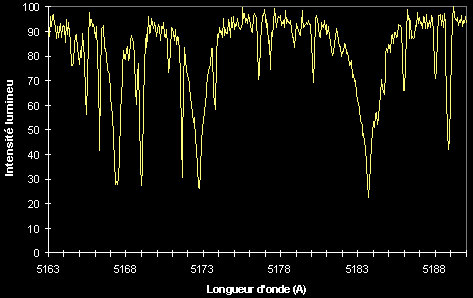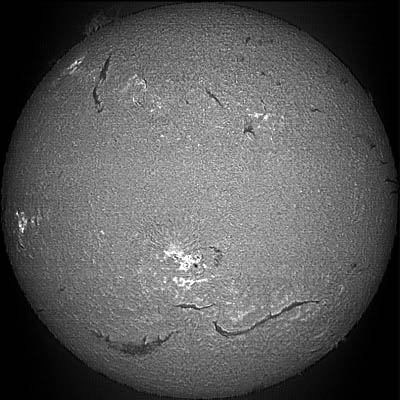|
Introduction
The study of the Sun in white light is generally limited to the measurement of sunspots position. It can be very interesting to obtain additional informations with spectrography. Dispersion of the light allows to reach the study of the composition of the solar atmosphere, the radial velocity measurement (Doppler effect) or intense magnetic fields (Zeeman effect) and direct but fragmentary observation of events in chromosphere (prominences, filaments, eruptions). The realization of a spectrograph is a first step but, to obtain a global monochromatic image of the Sun it is a spectroheliograph that it will be necessary to build.
Reminders - Principle of the optical assembly
The spectrograph gives an infinity of images of its entrance slit distributed according to wavelength. Observation of the solar spectrum shows a luminous band going from purple to red, streaked perpendicularly with a multitude of dark lines (fig. 1). These lines are the result of the absorption of the light emitted at photospheric level by the chromosphere and by the earth atmosphere.

Fig.1 - Portion of solar spectrum : the
sodium doublet.
If optical elements are good quality and if the dispersion is great, the details of the image passing by the entrance slit will be visible in the spectrum; for example, a sunspot will form a dark line going from purple to red, a prominence will reveal brilliant prolongations for some lines, etc.... We speak then of spectrography with spatial resolution.
Now let's isolate a very narrow portion of the
spectrum, for example by means of a second slit placed at the focus of
the camera lens. We obtain a monochromatic image of the portion of the
solar disc passing through the entrance slit. By scanning line by line
the sun image and by recording the corresponding monochromatic images,
one can thus reconstitute all the surface of the solar disc in a selected
wavelength and obtain a spectroheliogram.
A spectrograph essentially consists of:
- A collector of light (O1) supplying a real image of the object to be studied, in this particular case the Sun
- An entrance slit ( Fe) intended to select a quasi-linear portion of the image
- A collimating optics (O2) allowing to make parallel the beam from the entrance slit
- A grating (R)
- A camera lens (O3) to form the real image of the dispersed beam (the spectrum)
- A system for observing (spectroscopy) or recording (spectrography) placed at the focus of the camera lens.

Fig. 2 - Plan of a spectroscope.
Un spectrohéliographe nécessite de plus:
- An exit slit limiting the passage of a spectral bandwidth (< 1 Å)
- A recording system allowing to reconstitute a 2D image from a series of monochromatic linear sections of the solar image.
Description of the used elements
This realized system is a spectrograph / spectroheliograph fixed on a telescope 115/900, thus directional. It results from this some constraints of size and weight so that the equatorial mount does not collapse. The purpose is to realize an assembly in "piggy-back" with a length equivalent to that of the telescope (about 800 mm), and a weight maximum from 3 to 4 kg.
The selected Assembly is Hale-Ebert design (fig
3), which has the advantage to be compact and does not introduce many
aberrations if the F/D ratio of optics is great. It allows the use of
a single mirror (or two small concentric) as collimator and camera.

Fig. 3 - The assembly (type Hale-Ebert).
- The collector
Observation of the Sun in plain and urban zone is strongly limited by the atmospheric turbulence: the resolution is about 2 seconds. The diameter of the objective can so be small, about 10 cms. A telescope 115/900 (F/D=8) gives an image of the Sun 8.4 mm in diameter. A divergent lens is placed before the focus to form an image enlarged 1.3 times outside the focuser. The new focal length is so about 1170 mm.
- The entrance slit
Its role is to limit the width of the image to a value corresponding to the diffraction spot of the grating. The light but also the heat are concentrated on the slit and if the first interests us very much, the second can only destroy our observations. Some precautions are necessary, namely: the material constituting the slit should reflect most of the radiations and conduct easily the absorbed fraction in all its mass to avoid any local heat accumulation susceptible to create a dilation, even a complete deterioration of the slit. Two brass plates 4 mm in thickness were bevelled, polished then fixed to a metal disc 3 mm in thickness and 45 mm in diameter. The space and the parallelism of blades can be adjusted under a binocular magnifying glass.
- The Dispersor
It is a plane reflexion grating, 60x60 mm , engraved 1180 lines/mm. Dispersion in the first order is such as one can exploit only a small portion of spectrum. This grating is obviously directional to choose the portion of the spectrum to be observed. The rotation is ensured by a small stepper motor and a system of speed reduction.
The spectral resolution depends on the total number of lines of the grating and the used order. A grating with 1180 grooves/mm and 60 mm aside, used in the 2-nd order, will have a theoretical resolution of 1180x60x2 = 141600. For a wavelength of 600 nm, one can separate two lines distant from 600/141600 = 0.004 nm
- The collimatrice and the camera lenses
The emerging beam, from the slit, is keeping its geometrical characteristics (F/D~10), it is necessary to make it parallel with a section equal to the diagonal of the grating, that is about 90 mm. The collimator should have at least this diameter and a 900 mm focal length. For reasons of weight and size, I opted for a spherical mirror 76 mm in diameter and 700 mm focal length. The camera is identical.
The support of the second mirror (camera) is placed on a slide channel allowing a correct focusing of the spectrum on the sensor.
- The system for direct observation
It is necessary to be able to observe visually the spectrum directly to control the state of the entrance slit or the centering over a wavelength. It is also possible, using a micrometer, to measure Doppler shifts, to observe prominences on the limb of the Sun, etc....
A small directional plane mirror returns the image of the spectrum upward the instrument where an eyepiece is placed.
- The sensor
It is a linear CCD (Charge Coupled Device) which
is in charge of recording spectra or monochromatic "cuts" of the Sun.
It was taken from a standard Handy black and white scanner after analysis
of the control signals. This sensor consists of 2048 pixels in the step
of 14 µm what gives a coverage of the spectrum of 28,67 mm (about 31
nm in the first order). Its micrometric positioning in the longitudinal
or transverse axis of the spectrum is also motorized. It is necessary
indeed, to make coincide the CCD with a spectral line, to reach an angular
precision of 0,01 degrees. The spectral sensibility of this sensor covers
a domain going from 800 to 350 nm about.
The sensor is commanded by a
microcomputer ATARI 1040 via an interface. A fast analogical / digital
converter 8 bits allows the numerization and memorization of the
data.
An operating software manages the parameters, the pretreatment and
the safeguard of the data. The possibility of seeing the signal of the
CCD in real time is essential to do adjustments, to select a spectral line,
to superimpose line on CCD, to choose exposure time and centring of the
images, etc....
Spectrograph characteristics
To aim towards the theoretical spectral resolution, it is necessary that the width of the entrance slit (Lfe) is near the dimension of the diffraction image of the grating. This value is obtained by the relation :
Lfe =
f3 . λ /
a
with f3
= focal length of the camera lens, λ =
wavelength (0,6 µm) and a = width enlightened of the grating. One obtains Lfe
= 7 µm. The dimension of pixels of the CCD being 14 µm, one sees so that the theoretical resolution will not be reached and that the width of the entrance slit can be about 14µm.
This dimension corresponds also to an angular separation of 2,5 seconds and thus the limit of the observable details on the Sun.
In practice, the realization of the slit, the alignment and the quality of optics not being perfected, there will be still some degradations of the characteristics. Within sight of the results, the reached spectral resolution is of approximately 0,01 nm (0,1 Å) in the second order. The monochromatic Images being realized in the first order, the bandwith will be 0,02 nm (0,2 Å) in best.
First results
In spectrograph mode, one obtains a photometric profile of a small portion of the spectrum (Fig 4). The exposure time is brief, 20 - 50 ms according to the wavelength.

Fig.4 - Portion of solar spectrum :
the magnesium triplet.
In spectroheliograph mode, the scanning of the image is made by the diurnal movement in about 128 seconds. The diameter of the sun image covering 800 pixels on the sensor, we should get 800 cuttings of the image during this time. The global time of acquisition of the CCD will be 160 ms per line.
The most interesting lines are obviously hydrogen (Ha, 6563 Å) revealing the active regions, the prominences and the filaments (Fig 5), and ionized calcium (K3 , 3934 Å) showing faculae and chromosperic network.

Fig. 5 - The Sun in Ha light (may
12, 1998)
The raw images often present aesthetic and geometrical defects. The first one takes the aspect of streak either with dark bands and are caused by irregularities of the slit or by passages of clouds. The second results from an imperfect synchronization between the diurnal movement and the duration of acquisition the image (stretching or compression) or of a light slope of the slit with regard to the North-south axis (distortion). Appropriate computer treatments minimize these defects and allow the orientation and the analysis of the images. It is for example possible to produce a synoptic map of each sun rotation (Fig 6) or to measure the angle of position of prominences.

Fig. 6 - Portion of a map in Ha light
Conclusion
Although the monochromatic filters are more convenient to use, the realization of a spectroheliograph keeps many advantages and constitutes a very interesting tool for solar observation. A coelostat would allow however to obtain a better precision, allowing to fix the spectroheliograph, what would eliminate flexions.
This realization - which is not as difficult as one could think - obliges however to approach varied domains (optics, mechanics, electronics and data processing) and could completely join within the activities of a motivated group of amateurs.
Bibliographie
Bruhat G.
- Le Soleil. Presses Universitaires de France, 1951.
Guillermier P., Koutchmy S. - Eclipses totales. Masson, 1998.
Leroy J.L. - Le Soleil au coronographe. Guide de l'observateur, tome 1.
Ouvrage collectif sous la direction de P. Martinez. S.A.P. éditeur.
1987.
Martres M.J., Boyer R., Costard F., Malherbe J.M., Olivieri G. - Le Soleil
au télescope. Guide de l'observateur, tome 1. Ouvrage collectif
sous la direction de P. Martinez. S.A.P. éditeur. 1987.
Saint-Pé O. - La spectrographie. Guide de l'observateur, tome 2.
Ouvrage collectif sous la direction de P. Martinez. S.A.P. éditeur.
1987.
Terrien J. - L'optique astronomique. Que sais-je ?. Presses Universitaires
de France, 1972.
|

 )
) )
)





